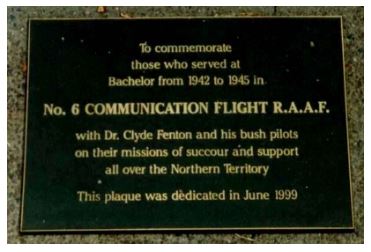No. 6 Communication Unit RAAF
From Our Contribution
 | |
Brief History
No. 6 Communication Unit was formed on 8 Dec 1942 at Manbulloo, Northern Territory, by taking over the bulk of aircraft, equipment and personnel of No. 34 Squadron. The unit's role included the ferrying of passengers, freight, and mail to units in the Northern Territory as well as conducting air-sea rescues, and Army and Navy co-operation flights and towing target drogues for anti-aircraft gunners. The unit was also called upon to perform medical evacuations to main hospitals or medical centers.
Locations serviced included outlying units at Groote Eylandt, Bathurst Island, Millingimbi, Port Keats. Broome, Derby, Noonkanbah, Victoria Raver Downs, Coomalie Creek, Daly Waters, Halls Creek, Wyndham, Drysdale and Oenpelli. Mercy flights were also flown to other isolated settlements or stations when needed. They flew a wide variety of aircraft including De Havilland DH.89 Dragon Rapide, De Havilland DH.82A Tiger Moth, Moth Minor, Avro Anson, Walrus, Vultee Vengeance, Lockheed Hudson, Consolidated PBY Catalina and the Bristol Beaufort.
On 27 February 1943 the unit moved from Manbulloo to Batchelor, and commenced operations from there. During March 1943 the Unit received the first of its Walrus aircraft. During April 1943 the Unit's Walrus aircraft began search and rescue flights over the Timor Sea, rescuring many pilots from the se and adjacent islands. The new year opened with two quick rescue missions. On 6 Jan 1944, a Walrus and a Dragon flew to Snake Bay to pickup five men who had escaped from the japanese on a lugger had arrived at Melville Island. On 15 Jan 1944, a Walrus rescued the crew of thr Unit's
survey Dragon which had force-landed on Maret Island, west of Drysdale. Thc aircraft was subsequently recovered. On 11 Mar 1944, two Dragons picked up six Filipino officers of the United States Army who had escaped from Borneo in an open boat.
During June 19-14 the Unit undertook several new and different tasks. Firstly, a mobile dental unit was established, and No. 6 Communication Unit
moved the dental unit around various parts of U1e Territory. Secondly a supply of films was organised and No. 6 Communication Unit delivered the
films to outlying units, the pilot often doubling as the cine operator. October and December 1944 were notable for numerous medical
evacuations flown.
Routine dut1es continued from Batcllelor until, on 7 Oct 1945, the Unit was moved to the Darwin civil aerodrome. Tasks were reducing as many outlying radar stations were closing down and being disbanded. No. 6 Communication Unit continued its work tendmg to the needs of units in the Northern Territory until 30 Dec 1945, when the Unit was disbanded at Darwln.
Unit Personnel
- Laurence Harold Smith 27 May 1943 - 26 Jun 1944
Notes